Detta inlägg post publicerades ursprungligen på denna sida this site ;
Date:
Author: Anthea Taylor, Associate Professor, Gender and Cultural Studies, University of Sydney
Original article: https://theconversation.com/australias-inconvenient-women-writers-blazed-a-trail-through-the-20th-century-254705
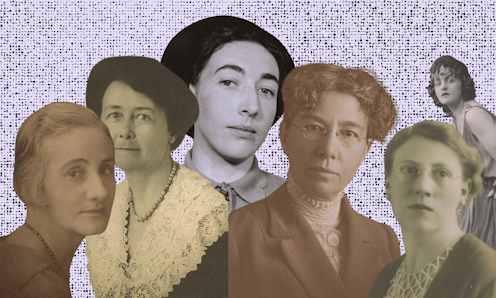
In Inconvenient Women, Jacqueline Kent shines a spotlight on some of Australia’s most radical and influential writers.
For Kent, these iconic women were “inconvenient” in many ways. They pursued careers as journalists, poets and novelists at times when many women were relegated to the private sphere. They spoke out against injustices, despite the personal cost. They lived unconventional lives, personally and professionally. And they embodied alternative forms of womanhood.
Review: Inconvenient Women: Australian Radical Writers 1900-1970 – Jacqueline Kent (NewSouth)
The limits of the “wave” metaphor to categorise periods of feminist activism are well known. Kent explicitly seeks to recentre women who were in between the “waves” – that is, she is interested in those who came after the campaigns for women’s suffrage during the so-called “first wave”, but predated the revitalisation of Western feminism in the “second wave” of the 1970s.
These women writers clearly laid some important foundations for later feminist activists, especially those who called for more radical social upheaval.
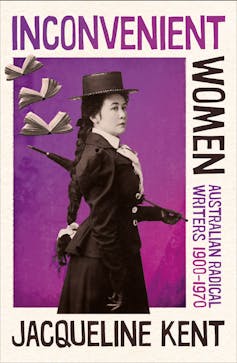
The book’s subtitle – “Australian radical writers” – clarifies its focus. Kent does not explicitly discuss the criteria for inclusion, but it becomes clear that “radical” is shorthand for the most left-leaning women writers and activists in the first two thirds of the 20th century.
Accordingly, much of the book is preoccupied with tracing their varied engagement with political ideas and organisations. As Kent clarifies in the book’s first few pages: “These were all women who used their power with words in support of their beliefs, and to question and change elements of the world they knew.”
Kent makes it clear, however, that this is a “joint biography”, not a work of history or literary criticism. Inconvenient Women focuses on how these women lived and how their literary contributions were informed – and indeed made possible – by their more unorthodox ways of being and living, rather than on the writing itself.
Kent puts it this way:
All these women were brave. Common to them all were unquenchable curiosity, fearlessness and willingness to take risks – with their lives, with their relationships, with the work they did.
Challenging norms
Written in an engaging and accessible style for a broad audience, Kent’s ambitious group biography places these formidable women at the forefront of Australia’s literary, cultural and political history. Spanning a period of 70 years, Kent maps the cultural and political shifts that enabled and constrained these women writers. Their activism took different forms across different periods, but for all of them writing was a key tool in their political arsenal.
The book’s five-part structure is chronological. Part one covers Federation, the granting of suffrage, and the first world war. It discusses a number of 20th-century writers who honed their skills in the journalistic field before publishing award-winning and often controversial novels.
Kent begins with journalist, poet and novelist Mary Gilmore. For more than two decades, from 1908 to 1931, Gilmore used the Women’s Page in the socialist magazine Worker to advocate for a mother’s allowance, support women who wished to eschew marriage, and criticise Christianity for its assumptions about women’s innate inferiority.
These ideas challenged the gender norms of the day, though in other respects, as Kent shows, Gilmore did little to disrupt prevailing ideologies. She supported the White Australia policy, for example.
In this opening section, Kent introduces several other women who return at various points in the biography, including Katharine Susannah Prichard, Miles Franklin, Marjorie Barnard and New Zealand-born novelist Jean Devanny.
Kent reflects upon the barriers encountered by these pioneering women authors. Devanny’s 1926 novel The Butcher Shop, which condemned the subservience of women in marriage, was the first book to be banned in Australia. Other lesser-known women whose work “hovered at the border of what was acceptable” included Jean Campbell, Doris Kerr and Marjorie Clark, who wrote under the pseudonym “Georgia Rivers”.
Kent’s commitment to reevaluating women writers who have not been foregrounded in literary or cultural history, such as poet Marie Pitt, is laudable. However, some of these figures – Marion Knowles and Elinor Mordaunt (the pen name of Evelyn May Clowes), for example – are only given short paragraphs. This reclamation is an important feature of the book, and I wanted to read more about these historically marginalised women.
Political dangers
Inconvenient Women is well researched and given texture through a variety of sources, including correspondence between some of these writers. Kent establishes how the subversive politics of her subjects informed their lives and their writing, and provides important insights into the communities they formed.
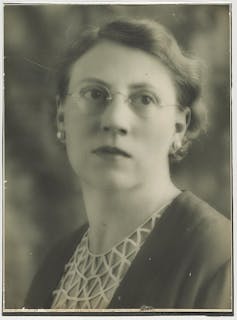
State Library of New South Wales, Public domain, via Wikimedia Commons
Many of these women supported each other across their often lengthy careers. Examining the intricate webs of connection and fruitful collaborative relationships – such as that between Marjorie Barnard and Flora Eldershaw, which produced novels, plays, short stories and essays – Kent foregrounds the intimacies of those who moved in literary and left political circles across the 20th century. This is one of the strengths of a group biography as a way of reframing histories from which women have been excluded.
At times, the focus turns to key male figures, such as journalist and communist activist Egon Kisch and Guido Barrachi, who was integral to the establishment of the Australian Communist Party and romantically involved with women writers such as Lesbia Harford and Betty Roland. This can distract from the book’s professed goal, though I acknowledge Kent’s introductory comment that “men figure in this story, too, both as antagonists and supporters”.
The extent to which the women’s writing overtly engaged with political issues varied, as did their positions on communism. While Prichard and Christina Stead wholeheartedly endorsed it, writer and critic Nettie Palmer appeared more ambivalent.
The second part of Inconvenient Women covers visits to the Soviet Union in the 1930s by Roland, Prichard, and Pamela Travers, the Australian-born author of Mary Poppins. Later in the decade, Palmer and Stead travelled to Spain, becoming caught up in the civil war and the protests against fascism. For Palmer, the experience cemented the importance of art as a “weapon”.
Continuing the book’s interest in women who may have been overlooked, Kent shows how Australian war correspondents, such as Women’s Weekly reporter Adele “Tilly” Shelton-Smith and Lorraine Stumm from the Daily Mail in England, played an important role during this tumultuous time.
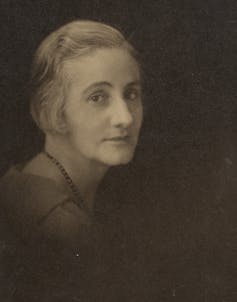
May Moore, Public domain, via Wikimedia Commons
Communism, Kent remarks, “influenced the work of some of Australia’s best women writers, whether they followed the Party or not”. This left them in vulnerable positions when war broke out in 1939. The third section of Inconvenient Woman considers how they responded to the second world war, personally and professionally. For many of them, this meant dealing with censorship, state surveillance and police raids on their homes.
To be a supporter of the left in the 1930s and 1940s, especially as a woman, could come at grave cost. Police raided Prichard’s house; Devanny was also subject to surveillance. As evidence of the oppressive political climate, Kent discusses how Dymphna Cusack, a teacher in inner-city Sydney, was transferred to Bathurst after the publication of Jungfrau (1936), her controversial novel exploring female sexuality. There were dangers in transgressing social mores.
As Kent shows, surveillance continued into the 1950s. Writers were increasingly subject to monitoring by ASIO. This included those who had received grants from the Commonwealth Literary Fund, such as Kylie Tennant, who returned the money after conservative parliamentarian Bill Wentworth publicly labelled her a communist.
The difficulties of publishing in such an environment, especially for women, are brought into sharp relief throughout the book. In the fourth section, which covers the years 1945–60, Kent addresses the difficulties experienced by women seeking to engage with the androcentric publishing industry. This is exemplified by the protracted publication journey of Come in Spinner (1951), co-written by Cusack and Florence James, which won a prize as an unpublished manuscript in 1946, only for its publication deal to be withdrawn. It eventually appeared five years later in an expurgated version.
Kent also emphasises how these women sought to ensure that writing be taken seriously as a form of labour. Many were involved in establishing and maintaining writers’ organisations. Gilmore and journalist Connie Robertson set up the Society of Women Writers in 1925, which was followed a few years later by a broader association, the Fellowship of Australian Writers, with Gilmore again at the forefront. Women were highly active, too, in the Australian Society of Authors, established in 1963 and still thriving today.
A formidable legacy
Despite living unconventional lives, Kent suggests many of these writers were not overt in their feminism. Dorothy Hewett’s social realist novel Bobbin’ Up represents a shift in this regard. Published in 1959, it is closer to the burgeoning modern women’s movement than any other literary text considered in the book.
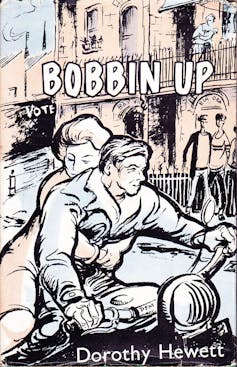
Given certain voices have historically been privileged over others, it is unsurprising that the majority of the women in this book are white and heterosexual. A little more reflection on the conditions that made their careers possible could have further illuminated how some “inconvenient” women in Australia, as elsewhere, have always been seen as more acceptable than others.
There is, nevertheless, an important discussion of Indigenous women writers and activists, including the poet Oodgeroo Noonuccal (Kath Walker) and the activist and writer Faith Bandler, in the book’s fifth and final section.
Inconvenient Women lacks a conclusion. Its account stops before the 1970s, a turbulent time of social and political change, when “inconvenient women” became more visible than at any other time in Australian history. Some additional gesturing towards subsequent developments might have given a stronger sense of how the foundations laid by these trailblazing women were built upon by second wave writers-as-activists, such as Germaine Greer and Anne Summers.
At different points in the book, I found myself wishing for further reflection on certain figures and the reception of their work. But this is a limitation of the group biography sub-genre rather than Kent’s writing. Inconvenient Women may function as an introduction for some readers, sparking curiosity about these remarkable women and a desire to seek out their books, plays and poems. For others, it might illuminate connections between these figures, or provide a deeper understanding of their cultural and historical contexts.
Whatever the case, Kent urges us to acknowledge and reconsider the legacy of these formidable Australian women. Each of them, in their own way, models what it is to be an “inconvenient” woman – something we certainly need now, perhaps more than ever.
![]()
Anthea Taylor does not work for, consult, own shares in or receive funding from any company or organisation that would benefit from this article, and has disclosed no relevant affiliations beyond their academic appointment.